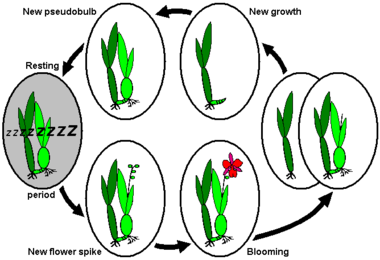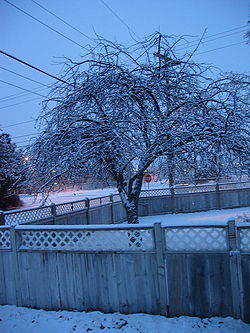- Dormancy
-
During winter dormancy, plant metabolism virtually comes to a standstill due, in part, to low temperatures that slow chemical activity.[1]

Dormancy is a period in an organism's life cycle when growth, development, and (in animals) physical activity are temporarily stopped. This minimizes metabolic activity and therefore helps an organism to conserve energy. Dormancy tends to be closely associated with environmental conditions. Organisms can synchronize entry to a dormant phase with their environment through predictive or consequential means. Predictive dormancy occurs when an organism enters a dormant phase before the onset of adverse conditions. For example, photoperiod and decreasing temperature are used by many plants to predict the onset of winter. Consequential dormancy occurs when organisms enter a dormant phase after adverse conditions have arisen. This is commonly found in areas with an unpredictable climate. While very sudden changes in conditions may lead to a high mortality rate among animals relying on consequential dormancy, its use can be advantageous, as organisms remain active longer and are therefore able to make greater use of available resources.
Contents
Animals
Hibernation
Hibernation is a mechanism used by many animals to escape cold weather and food shortage over the winter. Hibernation may be predictive or consequential. An animal prepares for hibernation by building up a thick layer of body fat during late summer and autumn that will provide it with energy during the dormant period. During hibernation, the animal undergoes many physiological changes, including decreased heart rate (by as much as 95%) and decreased body temperature. Animals that hibernate include bats, ground squirrels and other rodents, mouse lemurs, the European Hedgehog and other insectivores, monotremes and marsupials.
Diapause
Diapause is a predictive strategy that is predetermined by an animal's genotype. Diapause is common in insects, allowing them to suspend development between autumn and spring, and in mammals such as the roe deer (Capreolus capreolus, the only ungulate with embryonal diapause), where a delay in attachment of the embryo to the uterine lining ensures that offspring are born in spring, when conditions are most favorable.
Aestivation
Main article: AestivationAestivation, also spelled estivation, is an example of consequential dormancy in response to very hot or dry conditions. It is common in invertebrates such as the garden snail and worm but also occurs in other animals such as the lungfish.
Brumation
Dormancy in reptiles is an example of brumation, which is similar to hibernation.[2][3] It differs from hibernation in the metabolic processes involved.[4]
Reptiles generally begin brumation in late fall (more specific times depend on the species). They will often wake up to drink water and return to "sleep". They can go months without food. Reptiles may want to eat more than usual before the brumation time but will eat less or refuse food as the temperature drops. However, they do need to drink water. The brumation period is anywhere from one to eight months depending on the air temperature and the size, age, and health of the reptile. During the first year of life, many small reptiles do not fully brumate, but rather slow down and eat less often. Brumation should not be confused with hibernation; when mammals hibernate, they are actually asleep; when reptiles brumate, they are less active, and their metabolism slows down so they just do not need to eat as often. Reptiles can often go through the whole winter without eating. Brumation is triggered by cold weather, lack of heat, and the decrease in the amount of hours of daylight in the winter.
Viruses
Viruses of the family Herpesvirus are notable for remaining dormant within cells in the human body. See, for example, varicella zoster virus, which in an individual causes first chickenpox, then shingles (herpes zoster). Concerning viruses, this dormancy is often referred to as latency or a latent infection. HIV produces a latent infection in lymphocytes,[5] and, at this stage in its life-cycle, it is called a provirus.[6]
This should not be confused with clinical latency.
Plants
In plant physiology, dormancy is a period of arrested plant growth. It is a survival strategy exhibited by many plant species, which enables them to survive in climates where part of the year is unsuitable for growth, such as winter or dry seasons.
Many plant species that exhibit dormancy have a biological clock that tells them when to slow activity and to prepare soft tissues for a period of freezing temperatures or water shortage. On the other hand, dormancy can be triggered after a normal growing season by decreasing temperatures, shortened day length, and/or a reduction in rainfall. The images below show two particularly widespread dormancy patterns amongst sympodially growing orchids:
 Annual life cycle of sympodially growing orchids with dormancy after completion of new growth/pseudobulb, e.g., Miltonia, or Odontoglossum
Annual life cycle of sympodially growing orchids with dormancy after completion of new growth/pseudobulb, e.g., Miltonia, or Odontoglossum
 Annual life cycle of sympodially growing orchids with dormancy after blooming, e.g., Cycnoches ventricosum, Dendrobium nobile, or Laelia
Annual life cycle of sympodially growing orchids with dormancy after blooming, e.g., Cycnoches ventricosum, Dendrobium nobile, or Laelia
Seeds
When a mature seed is placed under favorable conditions and fails to germinate, it is said to be dormant. Seed dormancy is referred to as embryo dormancy or internal dormancy and is caused by endogenous characteristics of the embryo that prevent germination (Black M, Butler J, Hughes M. 1987). The oldest seed that has been germinated into a viable plant was an approximately 1,300-year-old lotus fruit recovered from a dry lakebed in northeastern China.[7] Dormancy should not be confused with seed coat dormancy, external dormancy, or hardseededness, which is caused by the presence of a hard seed covering or seed coat that prevents water and oxygen from reaching and activating the embryo. It is a physical barrier to germination, not a true form of dormancy (Quinliven, 1971; Quinliven and Nichol, 1971).
Trees
Tree species that have well-developed dormancy needs may be tricked to some degree, but not completely. For instance, if a Japanese Maple (Acer palmatum) is given an "eternal summer" through exposure to additional daylight, it will grow continuously for as long as two years. Eventually, however, a temperate climate plant will automatically go dormant, no matter what environmental conditions it experiences. Deciduous plants will lose their leaves; evergreens will curtail all new growth. Going through an "eternal summer" and the resultant automatic dormancy is stressful to the plant and usually fatal. The fatality rate increases to 100% if the plant does not receive the necessary period of cold temperatures required to break the dormancy. Most plants will require a certain number of hours of "chilling" at temperatures between about 0°C and 10°C to be able to break dormancy (Bewley, Black, 1994).
Bacteria
Many bacteria can survive adverse conditions such as temperature, desiccation, and antibiotics by endospores, cysts, conidia or states of reduced metabolic activity lacking specialized cellular structures.[8] Up to 80% of the bacteria in samples from the wild appear to be metabolically inactive[9]—many of which can be resuscitated.[10] Such dormancy is responsible for the high diversity levels of most natural ecosystems.[11]
See also
References
- ^ Capon, Brian (2005). Botany for gardeners. Timber Press: Timber Press. p. 146. ISBN 0881926558. http://books.google.com/?id=Z2s9v__6rp4C. Retrieved 2009-09-12.
- ^ Reptilian Brumation
- ^ Brumation
- ^ Brumation
- ^ Bagasra O (2006). "A unified concept of HIV latency". Expert Opin Biol Ther 6 (11): 1135–49. doi:10.1517/14712598.6.11.1135. PMID 17049012.
- ^ Margolis DM, Archin NM (2006). "Attacking HIV provirus: therapeutic strategies to disrupt persistent infection". Infect Disord Drug Targets 6 (4): 369–76. doi:10.2174/187152606779025824. PMID 17168802.
- ^ Long-living lotus: germination and soil {gamma}-irradiation of centuries-old fruits, and cultivation, growth, and phenotypic abnormalities of offspring, 2002, American Journal of Botany Vol. 89:236-247.
- ^ Sussman AS, Douthit HA (1973). Dormancy in microbial spores. Annu Rev Plant Physiol 24:311–352.
- ^ Cole JJ (1999). Aquatic microbiology for ecosystem scientists: New and recycled paradigms in ecological microbiology. Ecosystems 2:215–225.
- ^ Choi JW, Sherr EB, Sherr BF (1996) Relation between presence-absence of a visible nucleoid and metabolic activity in bacterioplankton cells. Limnol Oceanogr 41:1161–1168.
- ^ Jones SE, Lennon JT. (2010). Dormancy contributes to the maintenance of microbial diversity. Proc Natl Acad Sci U S A. 107:5881–5886 doi:10.1073/pnas.0912765107 PMID 20231463
Bewley, J. D. and Black, M. (1994). Seeds: physiology of development and germination, 2nd edn. New York, London: Plenum Press.
Black, M.; Butler, J. and Hughes, M. (1987). "Control and development of dormancy in cereals". In: Mares DJ, ed. Fourth International Symposium on Pre-Harvest Sprouting in Cereals, Boulder, Co., USA: Westview Press, 379-92.
Quinlivan, B. J. and Nicol, H. I. (1971). "Embryo dormancy in subterranean clover seeds. I. Environmental control". Australian Journal of Agricultural Research, 1971, 599-606.
Quinlivan, B. J. (1971). "Seed coat impermeability in legumes". Journal of the Australian Institute of Agricultural Science, 37, 283-295.
Scholar team. (2002). "SQA Adv. Higher Biology". Environmental Biology. Heriot Watt University, 93–95.
Categories:
Wikimedia Foundation. 2010.


